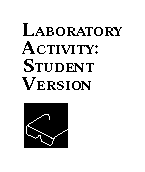
 Activity 1: Analysis of NaCl in Snack Food.
Activity 1: Analysis of NaCl in Snack Food.
Introduction
Table salt (sodium chloride, NaCl) is an important component of the human diet. Since too much salt may cause health problems such as high blood pressure or kidney and heart disease, "low salt" or "low sodium" foods have become popular and are readily available. Additionally, the Federal Government requires all food to be labeled with its nutritional components, including sodium. In this laboratory activity, you will determine the actual amount of NaCl in Fritos® snack food.
Prior to the laboratory, your instructor soaked a known amount of Fritos® in distilled water to dissolve the salt. You will be given the information about the mass of Fritos® used and the total volume of the solution obtained. You are to assume that all the salt from the Fritos® dissolved.
Purpose
To determine the mass of NaCl in a package of Fritos® using the Mohr chloride titration method.
Safety
- Wear protective goggles and apron throughout the laboratory activity.
- Silver nitrate (AgNO3) solutions stain skin and clothes; wash off immediately to prevent stains.
- Potassium chromate (K2CrO4) is toxic if taken internally, and may irritate the skin. Wash off immediately to prevent skin irritation.
Part I Procedure
- Obtain from your instructor information about the mass of Fritos® used and the total volume of the solution. Record these values in your Data Table.
- Fill the buret above the 50-mL mark with the AgNO3 solution. Open the stopcock to fill the buret tip and remove the bubbles. Record the Initial Reading for the Blank analysis in the Data Table. (The buret level does NOT have to be at 0.0 mL.)
- Blank titration: Using a pipette, transfer 10.0 mL distilled or deionized water into a 125-mL Erlenmeyer flask and add 20 drops chromate indicator. Titrate with the AgNO3 solution to a pinkish-orange end point. Record the mL of AgNO3 used. Repeat 2-3 times and average the values. A blank value of 0.2-0.3 mL is normal.
- Sample titration: Using a pipet, transfer 10.0-mL Fritos® filtrate into a 125-mL flask and add 20 drops chromate indicator. Titrate with AgNO3 until a pinkish-orange end point is reached. It should look almost like orange juice. Keep this titration flask for comparison with the next trial. Repeat Step 4 two additional times and record in the Data Table. If your results are not consistent (+/- 0.5 mL), you should do additional sample titrations.
- When you have completed the titrations, clean your buret as directed by your instructor. Remember that AgNO3 stains the skin. Titrations solutions should be disposed of as directed by your instructor.
- Thoroughly wash your hands before leaving the laboratory.
Continue


 Activity 1: Analysis of NaCl in Snack Food.
Activity 1: Analysis of NaCl in Snack Food.

